Analysis and Recommendations: Celanese ITIL Implementation Report
VerifiedAdded on 2022/12/30
|10
|2435
|93
Report
AI Summary
This report provides an in-depth analysis of Celanese's implementation of the ITIL framework, examining its impact on the organization's IT service management. The report begins with an executive summary highlighting the benefits of ITIL in delivering value to customers and supporting decision-making. It then delves into the introduction of ITIL, emphasizing its role as a standard in IT service management and its evolution to ITIL v4. The analysis covers how ITIL can improve IT operations, manage service lifecycles, and mitigate risks. The report includes recommendations for Celanese, such as improving service level management and transparency. Furthermore, it presents a self-assessment of Celanese's IT operations, identifying areas for improvement based on HP's maturity model and cost-cutting initiatives. The report also outlines the benefits of process improvements, including increased productivity and customer satisfaction. It concludes by addressing limitations of the ITIL approach and suggesting strategies to minimize challenges during implementation. References are included to support the analysis.

Running head: ITIL
ITIL
Name of Student
Name of University
Author’s Note
ITIL
Name of Student
Name of University
Author’s Note
Paraphrase This Document
Need a fresh take? Get an instant paraphrase of this document with our AI Paraphraser
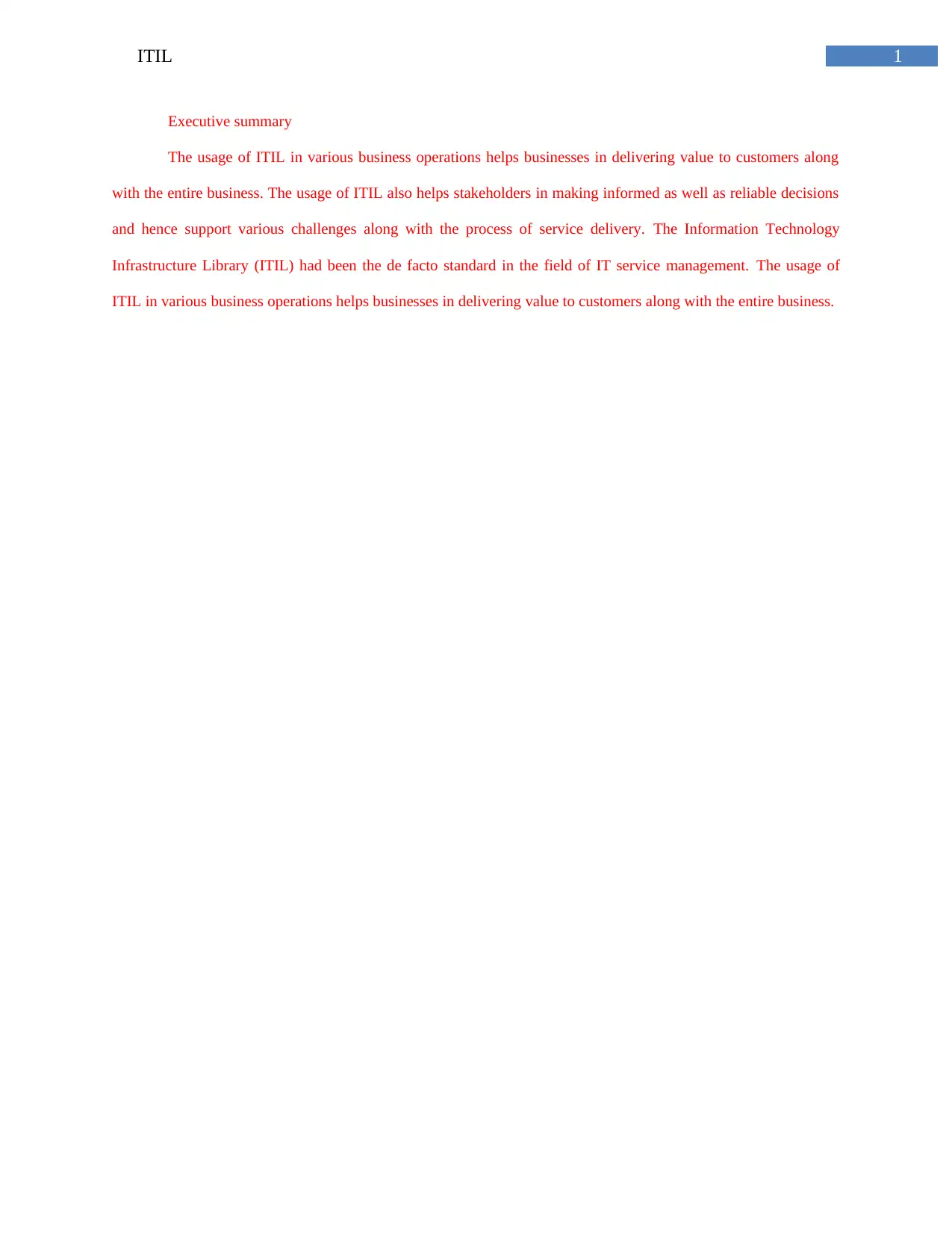
1ITIL
Executive summary
The usage of ITIL in various business operations helps businesses in delivering value to customers along
with the entire business. The usage of ITIL also helps stakeholders in making informed as well as reliable decisions
and hence support various challenges along with the process of service delivery. The Information Technology
Infrastructure Library (ITIL) had been the de facto standard in the field of IT service management. The usage of
ITIL in various business operations helps businesses in delivering value to customers along with the entire business.
Executive summary
The usage of ITIL in various business operations helps businesses in delivering value to customers along
with the entire business. The usage of ITIL also helps stakeholders in making informed as well as reliable decisions
and hence support various challenges along with the process of service delivery. The Information Technology
Infrastructure Library (ITIL) had been the de facto standard in the field of IT service management. The usage of
ITIL in various business operations helps businesses in delivering value to customers along with the entire business.
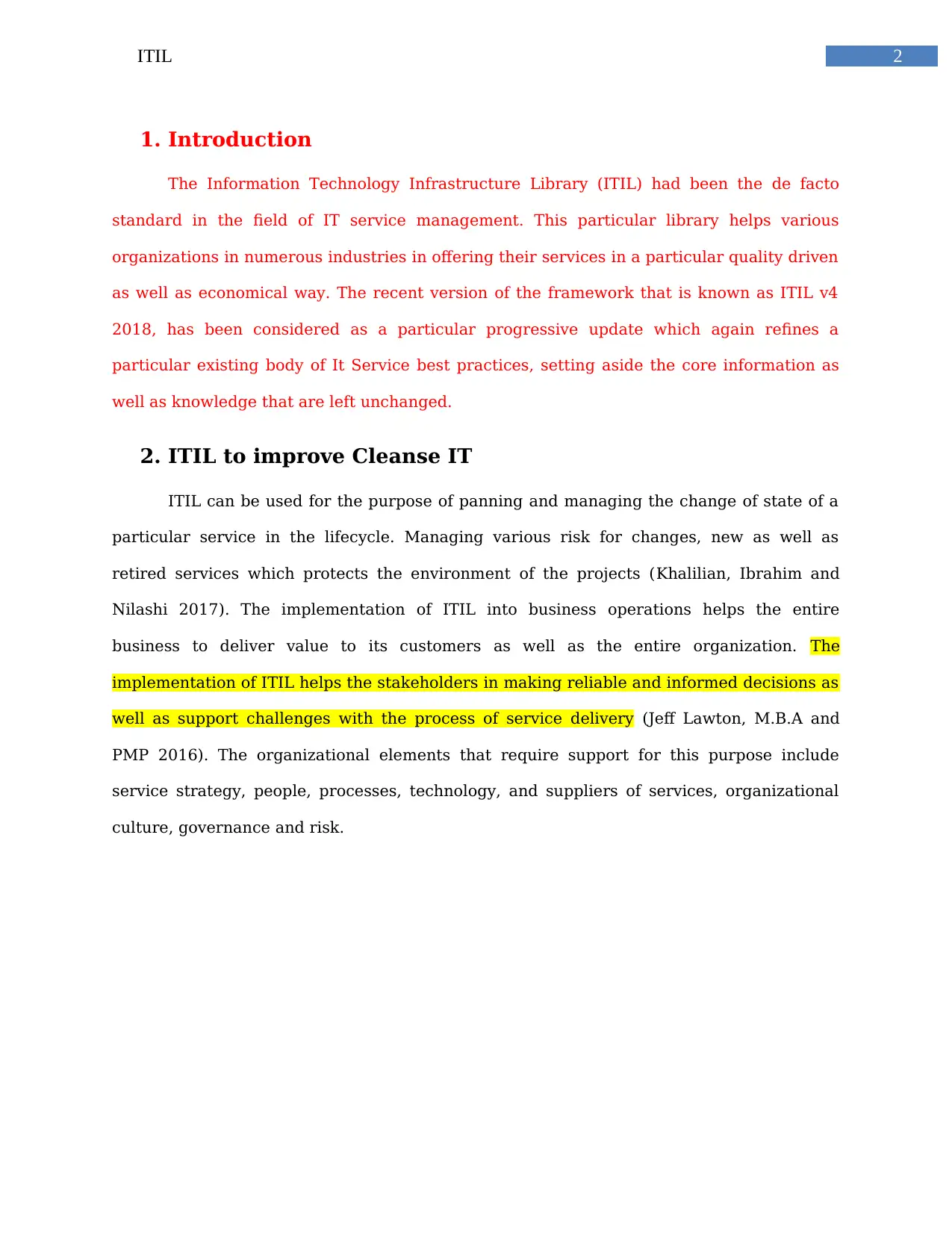
2ITIL
1. Introduction
The Information Technology Infrastructure Library (ITIL) had been the de facto
standard in the field of IT service management. This particular library helps various
organizations in numerous industries in offering their services in a particular quality driven
as well as economical way. The recent version of the framework that is known as ITIL v4
2018, has been considered as a particular progressive update which again refines a
particular existing body of It Service best practices, setting aside the core information as
well as knowledge that are left unchanged.
2. ITIL to improve Cleanse IT
ITIL can be used for the purpose of panning and managing the change of state of a
particular service in the lifecycle. Managing various risk for changes, new as well as
retired services which protects the environment of the projects (Khalilian, Ibrahim and
Nilashi 2017). The implementation of ITIL into business operations helps the entire
business to deliver value to its customers as well as the entire organization. The
implementation of ITIL helps the stakeholders in making reliable and informed decisions as
well as support challenges with the process of service delivery (Jeff Lawton, M.B.A and
PMP 2016). The organizational elements that require support for this purpose include
service strategy, people, processes, technology, and suppliers of services, organizational
culture, governance and risk.
1. Introduction
The Information Technology Infrastructure Library (ITIL) had been the de facto
standard in the field of IT service management. This particular library helps various
organizations in numerous industries in offering their services in a particular quality driven
as well as economical way. The recent version of the framework that is known as ITIL v4
2018, has been considered as a particular progressive update which again refines a
particular existing body of It Service best practices, setting aside the core information as
well as knowledge that are left unchanged.
2. ITIL to improve Cleanse IT
ITIL can be used for the purpose of panning and managing the change of state of a
particular service in the lifecycle. Managing various risk for changes, new as well as
retired services which protects the environment of the projects (Khalilian, Ibrahim and
Nilashi 2017). The implementation of ITIL into business operations helps the entire
business to deliver value to its customers as well as the entire organization. The
implementation of ITIL helps the stakeholders in making reliable and informed decisions as
well as support challenges with the process of service delivery (Jeff Lawton, M.B.A and
PMP 2016). The organizational elements that require support for this purpose include
service strategy, people, processes, technology, and suppliers of services, organizational
culture, governance and risk.
⊘ This is a preview!⊘
Do you want full access?
Subscribe today to unlock all pages.

Trusted by 1+ million students worldwide
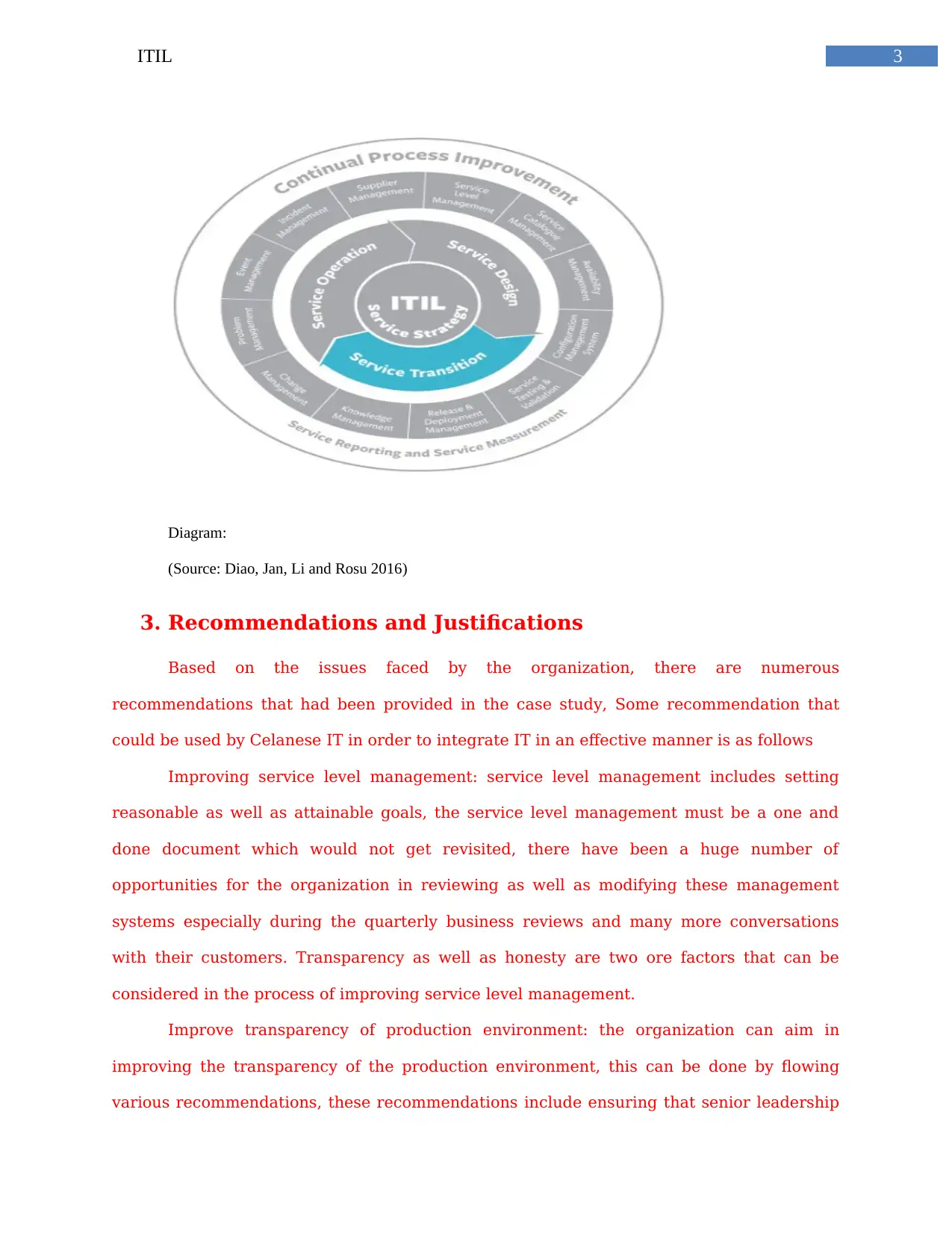
3ITIL
Diagram:
(Source: Diao, Jan, Li and Rosu 2016)
3. Recommendations and Justifications
Based on the issues faced by the organization, there are numerous
recommendations that had been provided in the case study, Some recommendation that
could be used by Celanese IT in order to integrate IT in an effective manner is as follows
Improving service level management: service level management includes setting
reasonable as well as attainable goals, the service level management must be a one and
done document which would not get revisited, there have been a huge number of
opportunities for the organization in reviewing as well as modifying these management
systems especially during the quarterly business reviews and many more conversations
with their customers. Transparency as well as honesty are two ore factors that can be
considered in the process of improving service level management.
Improve transparency of production environment: the organization can aim in
improving the transparency of the production environment, this can be done by flowing
various recommendations, these recommendations include ensuring that senior leadership
Diagram:
(Source: Diao, Jan, Li and Rosu 2016)
3. Recommendations and Justifications
Based on the issues faced by the organization, there are numerous
recommendations that had been provided in the case study, Some recommendation that
could be used by Celanese IT in order to integrate IT in an effective manner is as follows
Improving service level management: service level management includes setting
reasonable as well as attainable goals, the service level management must be a one and
done document which would not get revisited, there have been a huge number of
opportunities for the organization in reviewing as well as modifying these management
systems especially during the quarterly business reviews and many more conversations
with their customers. Transparency as well as honesty are two ore factors that can be
considered in the process of improving service level management.
Improve transparency of production environment: the organization can aim in
improving the transparency of the production environment, this can be done by flowing
various recommendations, these recommendations include ensuring that senior leadership
Paraphrase This Document
Need a fresh take? Get an instant paraphrase of this document with our AI Paraphraser
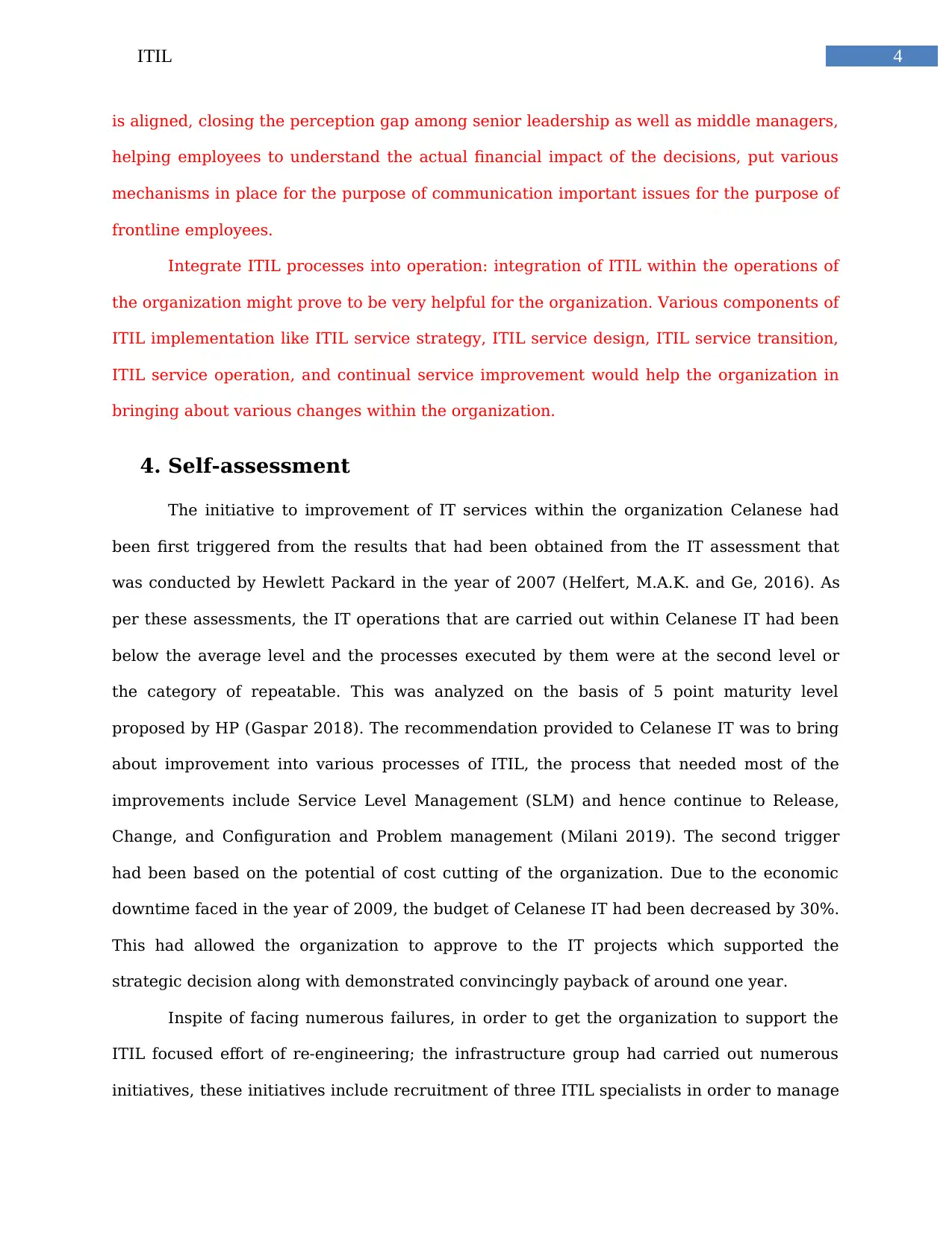
4ITIL
is aligned, closing the perception gap among senior leadership as well as middle managers,
helping employees to understand the actual financial impact of the decisions, put various
mechanisms in place for the purpose of communication important issues for the purpose of
frontline employees.
Integrate ITIL processes into operation: integration of ITIL within the operations of
the organization might prove to be very helpful for the organization. Various components of
ITIL implementation like ITIL service strategy, ITIL service design, ITIL service transition,
ITIL service operation, and continual service improvement would help the organization in
bringing about various changes within the organization.
4. Self-assessment
The initiative to improvement of IT services within the organization Celanese had
been first triggered from the results that had been obtained from the IT assessment that
was conducted by Hewlett Packard in the year of 2007 (Helfert, M.A.K. and Ge, 2016). As
per these assessments, the IT operations that are carried out within Celanese IT had been
below the average level and the processes executed by them were at the second level or
the category of repeatable. This was analyzed on the basis of 5 point maturity level
proposed by HP (Gaspar 2018). The recommendation provided to Celanese IT was to bring
about improvement into various processes of ITIL, the process that needed most of the
improvements include Service Level Management (SLM) and hence continue to Release,
Change, and Configuration and Problem management (Milani 2019). The second trigger
had been based on the potential of cost cutting of the organization. Due to the economic
downtime faced in the year of 2009, the budget of Celanese IT had been decreased by 30%.
This had allowed the organization to approve to the IT projects which supported the
strategic decision along with demonstrated convincingly payback of around one year.
Inspite of facing numerous failures, in order to get the organization to support the
ITIL focused effort of re-engineering; the infrastructure group had carried out numerous
initiatives, these initiatives include recruitment of three ITIL specialists in order to manage
is aligned, closing the perception gap among senior leadership as well as middle managers,
helping employees to understand the actual financial impact of the decisions, put various
mechanisms in place for the purpose of communication important issues for the purpose of
frontline employees.
Integrate ITIL processes into operation: integration of ITIL within the operations of
the organization might prove to be very helpful for the organization. Various components of
ITIL implementation like ITIL service strategy, ITIL service design, ITIL service transition,
ITIL service operation, and continual service improvement would help the organization in
bringing about various changes within the organization.
4. Self-assessment
The initiative to improvement of IT services within the organization Celanese had
been first triggered from the results that had been obtained from the IT assessment that
was conducted by Hewlett Packard in the year of 2007 (Helfert, M.A.K. and Ge, 2016). As
per these assessments, the IT operations that are carried out within Celanese IT had been
below the average level and the processes executed by them were at the second level or
the category of repeatable. This was analyzed on the basis of 5 point maturity level
proposed by HP (Gaspar 2018). The recommendation provided to Celanese IT was to bring
about improvement into various processes of ITIL, the process that needed most of the
improvements include Service Level Management (SLM) and hence continue to Release,
Change, and Configuration and Problem management (Milani 2019). The second trigger
had been based on the potential of cost cutting of the organization. Due to the economic
downtime faced in the year of 2009, the budget of Celanese IT had been decreased by 30%.
This had allowed the organization to approve to the IT projects which supported the
strategic decision along with demonstrated convincingly payback of around one year.
Inspite of facing numerous failures, in order to get the organization to support the
ITIL focused effort of re-engineering; the infrastructure group had carried out numerous
initiatives, these initiatives include recruitment of three ITIL specialists in order to manage
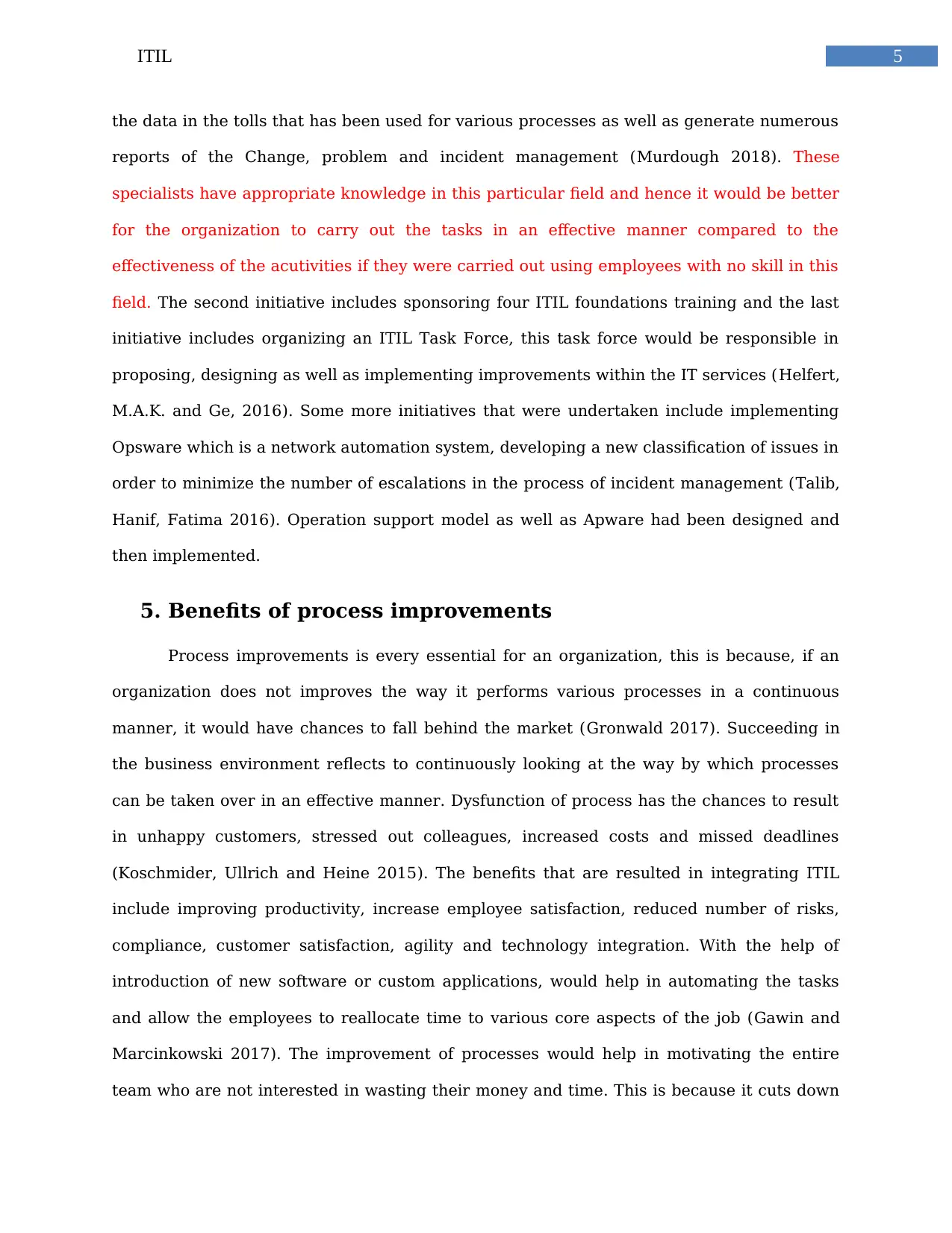
5ITIL
the data in the tolls that has been used for various processes as well as generate numerous
reports of the Change, problem and incident management (Murdough 2018). These
specialists have appropriate knowledge in this particular field and hence it would be better
for the organization to carry out the tasks in an effective manner compared to the
effectiveness of the acutivities if they were carried out using employees with no skill in this
field. The second initiative includes sponsoring four ITIL foundations training and the last
initiative includes organizing an ITIL Task Force, this task force would be responsible in
proposing, designing as well as implementing improvements within the IT services (Helfert,
M.A.K. and Ge, 2016). Some more initiatives that were undertaken include implementing
Opsware which is a network automation system, developing a new classification of issues in
order to minimize the number of escalations in the process of incident management (Talib,
Hanif, Fatima 2016). Operation support model as well as Apware had been designed and
then implemented.
5. Benefits of process improvements
Process improvements is every essential for an organization, this is because, if an
organization does not improves the way it performs various processes in a continuous
manner, it would have chances to fall behind the market (Gronwald 2017). Succeeding in
the business environment reflects to continuously looking at the way by which processes
can be taken over in an effective manner. Dysfunction of process has the chances to result
in unhappy customers, stressed out colleagues, increased costs and missed deadlines
(Koschmider, Ullrich and Heine 2015). The benefits that are resulted in integrating ITIL
include improving productivity, increase employee satisfaction, reduced number of risks,
compliance, customer satisfaction, agility and technology integration. With the help of
introduction of new software or custom applications, would help in automating the tasks
and allow the employees to reallocate time to various core aspects of the job (Gawin and
Marcinkowski 2017). The improvement of processes would help in motivating the entire
team who are not interested in wasting their money and time. This is because it cuts down
the data in the tolls that has been used for various processes as well as generate numerous
reports of the Change, problem and incident management (Murdough 2018). These
specialists have appropriate knowledge in this particular field and hence it would be better
for the organization to carry out the tasks in an effective manner compared to the
effectiveness of the acutivities if they were carried out using employees with no skill in this
field. The second initiative includes sponsoring four ITIL foundations training and the last
initiative includes organizing an ITIL Task Force, this task force would be responsible in
proposing, designing as well as implementing improvements within the IT services (Helfert,
M.A.K. and Ge, 2016). Some more initiatives that were undertaken include implementing
Opsware which is a network automation system, developing a new classification of issues in
order to minimize the number of escalations in the process of incident management (Talib,
Hanif, Fatima 2016). Operation support model as well as Apware had been designed and
then implemented.
5. Benefits of process improvements
Process improvements is every essential for an organization, this is because, if an
organization does not improves the way it performs various processes in a continuous
manner, it would have chances to fall behind the market (Gronwald 2017). Succeeding in
the business environment reflects to continuously looking at the way by which processes
can be taken over in an effective manner. Dysfunction of process has the chances to result
in unhappy customers, stressed out colleagues, increased costs and missed deadlines
(Koschmider, Ullrich and Heine 2015). The benefits that are resulted in integrating ITIL
include improving productivity, increase employee satisfaction, reduced number of risks,
compliance, customer satisfaction, agility and technology integration. With the help of
introduction of new software or custom applications, would help in automating the tasks
and allow the employees to reallocate time to various core aspects of the job (Gawin and
Marcinkowski 2017). The improvement of processes would help in motivating the entire
team who are not interested in wasting their money and time. This is because it cuts down
⊘ This is a preview!⊘
Do you want full access?
Subscribe today to unlock all pages.

Trusted by 1+ million students worldwide
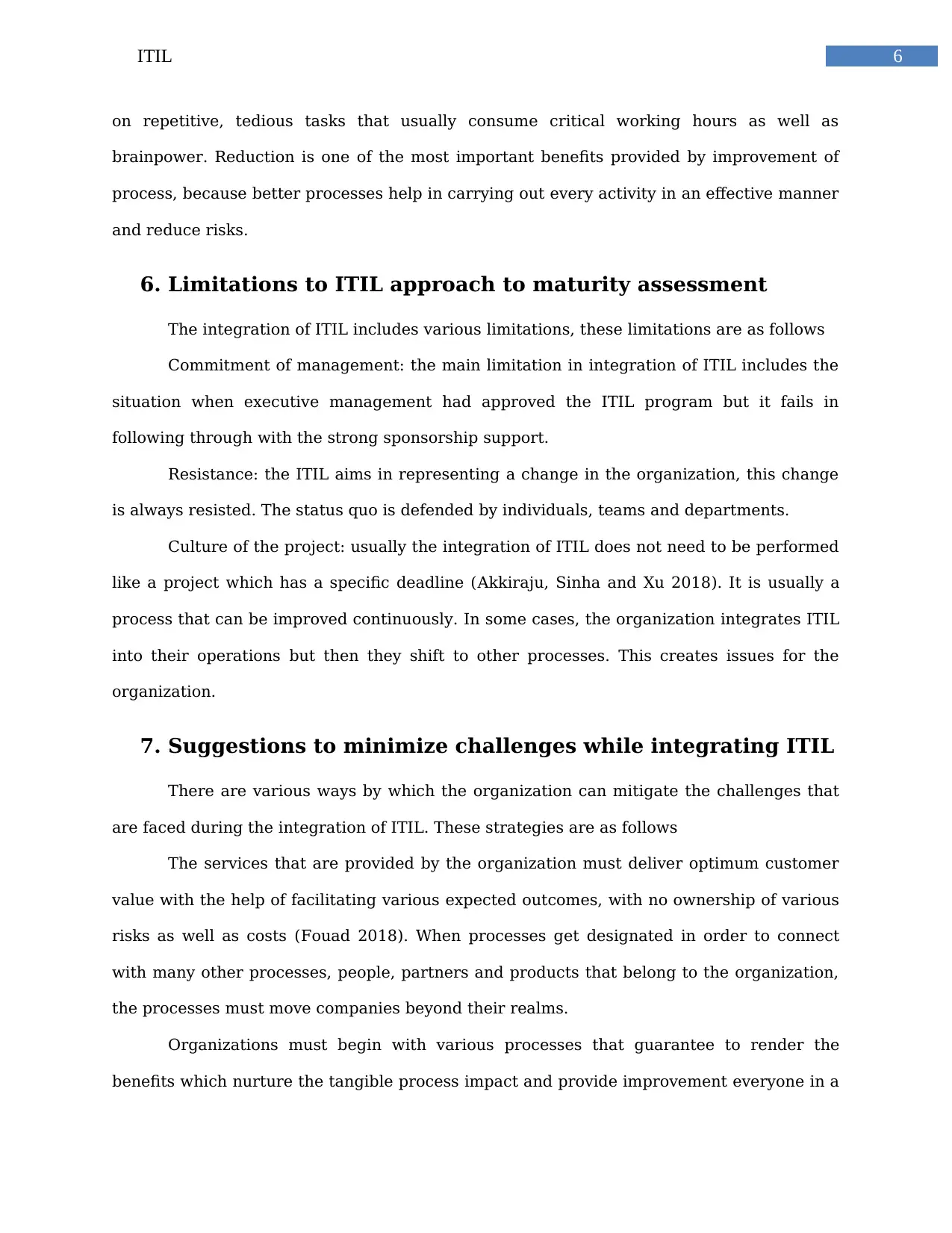
6ITIL
on repetitive, tedious tasks that usually consume critical working hours as well as
brainpower. Reduction is one of the most important benefits provided by improvement of
process, because better processes help in carrying out every activity in an effective manner
and reduce risks.
6. Limitations to ITIL approach to maturity assessment
The integration of ITIL includes various limitations, these limitations are as follows
Commitment of management: the main limitation in integration of ITIL includes the
situation when executive management had approved the ITIL program but it fails in
following through with the strong sponsorship support.
Resistance: the ITIL aims in representing a change in the organization, this change
is always resisted. The status quo is defended by individuals, teams and departments.
Culture of the project: usually the integration of ITIL does not need to be performed
like a project which has a specific deadline (Akkiraju, Sinha and Xu 2018). It is usually a
process that can be improved continuously. In some cases, the organization integrates ITIL
into their operations but then they shift to other processes. This creates issues for the
organization.
7. Suggestions to minimize challenges while integrating ITIL
There are various ways by which the organization can mitigate the challenges that
are faced during the integration of ITIL. These strategies are as follows
The services that are provided by the organization must deliver optimum customer
value with the help of facilitating various expected outcomes, with no ownership of various
risks as well as costs (Fouad 2018). When processes get designated in order to connect
with many other processes, people, partners and products that belong to the organization,
the processes must move companies beyond their realms.
Organizations must begin with various processes that guarantee to render the
benefits which nurture the tangible process impact and provide improvement everyone in a
on repetitive, tedious tasks that usually consume critical working hours as well as
brainpower. Reduction is one of the most important benefits provided by improvement of
process, because better processes help in carrying out every activity in an effective manner
and reduce risks.
6. Limitations to ITIL approach to maturity assessment
The integration of ITIL includes various limitations, these limitations are as follows
Commitment of management: the main limitation in integration of ITIL includes the
situation when executive management had approved the ITIL program but it fails in
following through with the strong sponsorship support.
Resistance: the ITIL aims in representing a change in the organization, this change
is always resisted. The status quo is defended by individuals, teams and departments.
Culture of the project: usually the integration of ITIL does not need to be performed
like a project which has a specific deadline (Akkiraju, Sinha and Xu 2018). It is usually a
process that can be improved continuously. In some cases, the organization integrates ITIL
into their operations but then they shift to other processes. This creates issues for the
organization.
7. Suggestions to minimize challenges while integrating ITIL
There are various ways by which the organization can mitigate the challenges that
are faced during the integration of ITIL. These strategies are as follows
The services that are provided by the organization must deliver optimum customer
value with the help of facilitating various expected outcomes, with no ownership of various
risks as well as costs (Fouad 2018). When processes get designated in order to connect
with many other processes, people, partners and products that belong to the organization,
the processes must move companies beyond their realms.
Organizations must begin with various processes that guarantee to render the
benefits which nurture the tangible process impact and provide improvement everyone in a
Paraphrase This Document
Need a fresh take? Get an instant paraphrase of this document with our AI Paraphraser
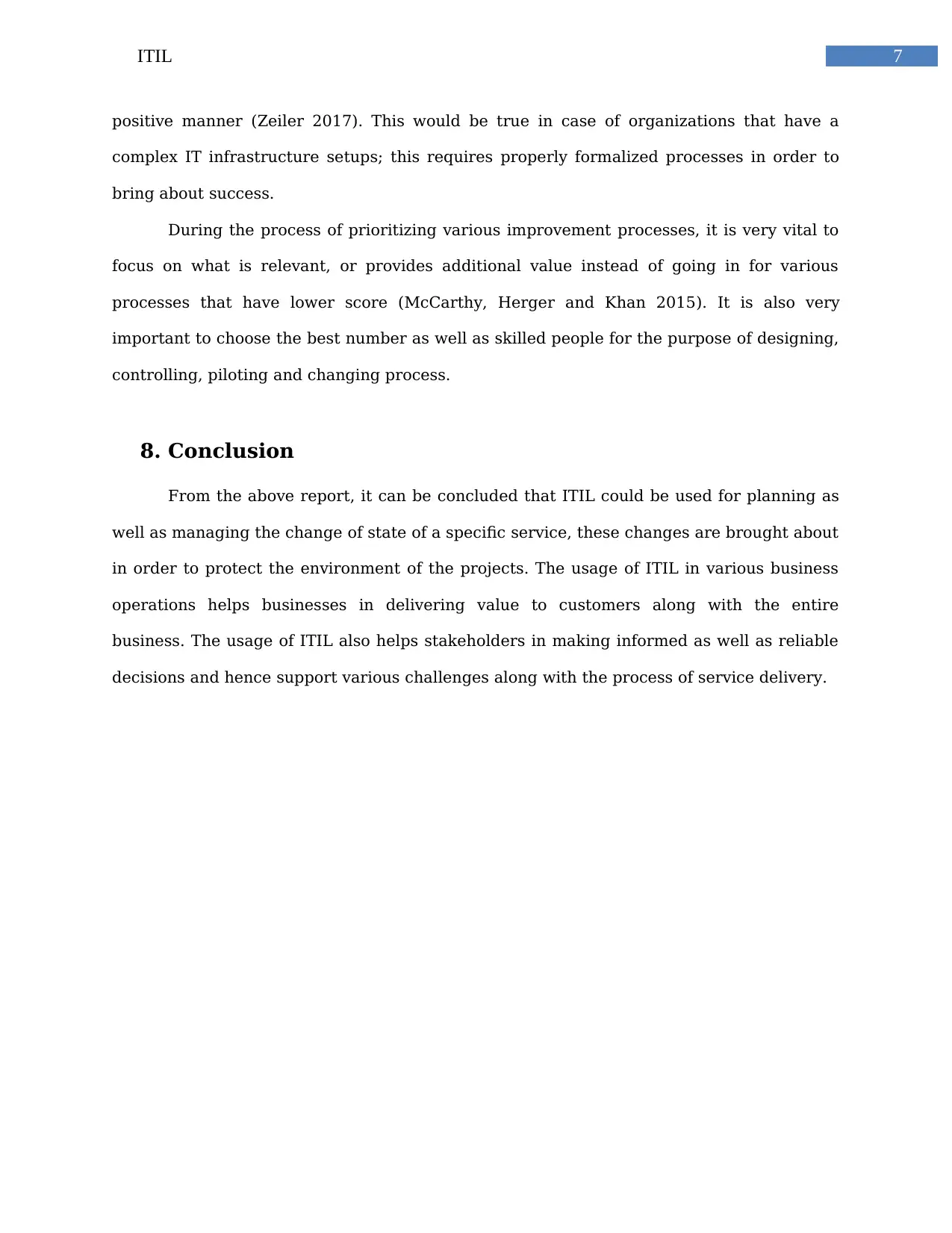
7ITIL
positive manner (Zeiler 2017). This would be true in case of organizations that have a
complex IT infrastructure setups; this requires properly formalized processes in order to
bring about success.
During the process of prioritizing various improvement processes, it is very vital to
focus on what is relevant, or provides additional value instead of going in for various
processes that have lower score (McCarthy, Herger and Khan 2015). It is also very
important to choose the best number as well as skilled people for the purpose of designing,
controlling, piloting and changing process.
8. Conclusion
From the above report, it can be concluded that ITIL could be used for planning as
well as managing the change of state of a specific service, these changes are brought about
in order to protect the environment of the projects. The usage of ITIL in various business
operations helps businesses in delivering value to customers along with the entire
business. The usage of ITIL also helps stakeholders in making informed as well as reliable
decisions and hence support various challenges along with the process of service delivery.
positive manner (Zeiler 2017). This would be true in case of organizations that have a
complex IT infrastructure setups; this requires properly formalized processes in order to
bring about success.
During the process of prioritizing various improvement processes, it is very vital to
focus on what is relevant, or provides additional value instead of going in for various
processes that have lower score (McCarthy, Herger and Khan 2015). It is also very
important to choose the best number as well as skilled people for the purpose of designing,
controlling, piloting and changing process.
8. Conclusion
From the above report, it can be concluded that ITIL could be used for planning as
well as managing the change of state of a specific service, these changes are brought about
in order to protect the environment of the projects. The usage of ITIL in various business
operations helps businesses in delivering value to customers along with the entire
business. The usage of ITIL also helps stakeholders in making informed as well as reliable
decisions and hence support various challenges along with the process of service delivery.
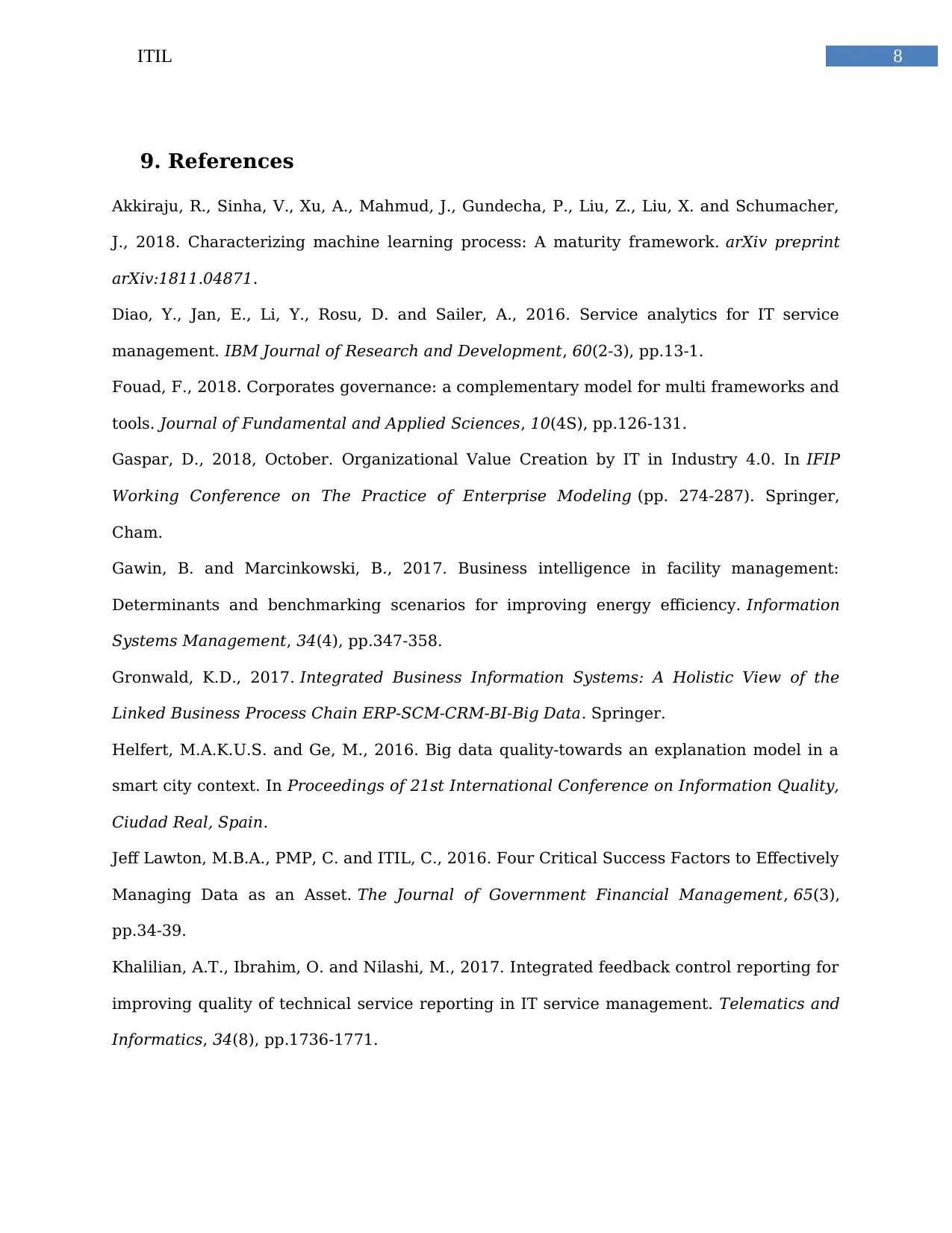
8ITIL
9. References
Akkiraju, R., Sinha, V., Xu, A., Mahmud, J., Gundecha, P., Liu, Z., Liu, X. and Schumacher,
J., 2018. Characterizing machine learning process: A maturity framework. arXiv preprint
arXiv:1811.04871.
Diao, Y., Jan, E., Li, Y., Rosu, D. and Sailer, A., 2016. Service analytics for IT service
management. IBM Journal of Research and Development, 60(2-3), pp.13-1.
Fouad, F., 2018. Corporates governance: a complementary model for multi frameworks and
tools. Journal of Fundamental and Applied Sciences, 10(4S), pp.126-131.
Gaspar, D., 2018, October. Organizational Value Creation by IT in Industry 4.0. In IFIP
Working Conference on The Practice of Enterprise Modeling (pp. 274-287). Springer,
Cham.
Gawin, B. and Marcinkowski, B., 2017. Business intelligence in facility management:
Determinants and benchmarking scenarios for improving energy efficiency. Information
Systems Management, 34(4), pp.347-358.
Gronwald, K.D., 2017. Integrated Business Information Systems: A Holistic View of the
Linked Business Process Chain ERP-SCM-CRM-BI-Big Data. Springer.
Helfert, M.A.K.U.S. and Ge, M., 2016. Big data quality-towards an explanation model in a
smart city context. In Proceedings of 21st International Conference on Information Quality,
Ciudad Real, Spain.
Jeff Lawton, M.B.A., PMP, C. and ITIL, C., 2016. Four Critical Success Factors to Effectively
Managing Data as an Asset. The Journal of Government Financial Management, 65(3),
pp.34-39.
Khalilian, A.T., Ibrahim, O. and Nilashi, M., 2017. Integrated feedback control reporting for
improving quality of technical service reporting in IT service management. Telematics and
Informatics, 34(8), pp.1736-1771.
9. References
Akkiraju, R., Sinha, V., Xu, A., Mahmud, J., Gundecha, P., Liu, Z., Liu, X. and Schumacher,
J., 2018. Characterizing machine learning process: A maturity framework. arXiv preprint
arXiv:1811.04871.
Diao, Y., Jan, E., Li, Y., Rosu, D. and Sailer, A., 2016. Service analytics for IT service
management. IBM Journal of Research and Development, 60(2-3), pp.13-1.
Fouad, F., 2018. Corporates governance: a complementary model for multi frameworks and
tools. Journal of Fundamental and Applied Sciences, 10(4S), pp.126-131.
Gaspar, D., 2018, October. Organizational Value Creation by IT in Industry 4.0. In IFIP
Working Conference on The Practice of Enterprise Modeling (pp. 274-287). Springer,
Cham.
Gawin, B. and Marcinkowski, B., 2017. Business intelligence in facility management:
Determinants and benchmarking scenarios for improving energy efficiency. Information
Systems Management, 34(4), pp.347-358.
Gronwald, K.D., 2017. Integrated Business Information Systems: A Holistic View of the
Linked Business Process Chain ERP-SCM-CRM-BI-Big Data. Springer.
Helfert, M.A.K.U.S. and Ge, M., 2016. Big data quality-towards an explanation model in a
smart city context. In Proceedings of 21st International Conference on Information Quality,
Ciudad Real, Spain.
Jeff Lawton, M.B.A., PMP, C. and ITIL, C., 2016. Four Critical Success Factors to Effectively
Managing Data as an Asset. The Journal of Government Financial Management, 65(3),
pp.34-39.
Khalilian, A.T., Ibrahim, O. and Nilashi, M., 2017. Integrated feedback control reporting for
improving quality of technical service reporting in IT service management. Telematics and
Informatics, 34(8), pp.1736-1771.
⊘ This is a preview!⊘
Do you want full access?
Subscribe today to unlock all pages.

Trusted by 1+ million students worldwide
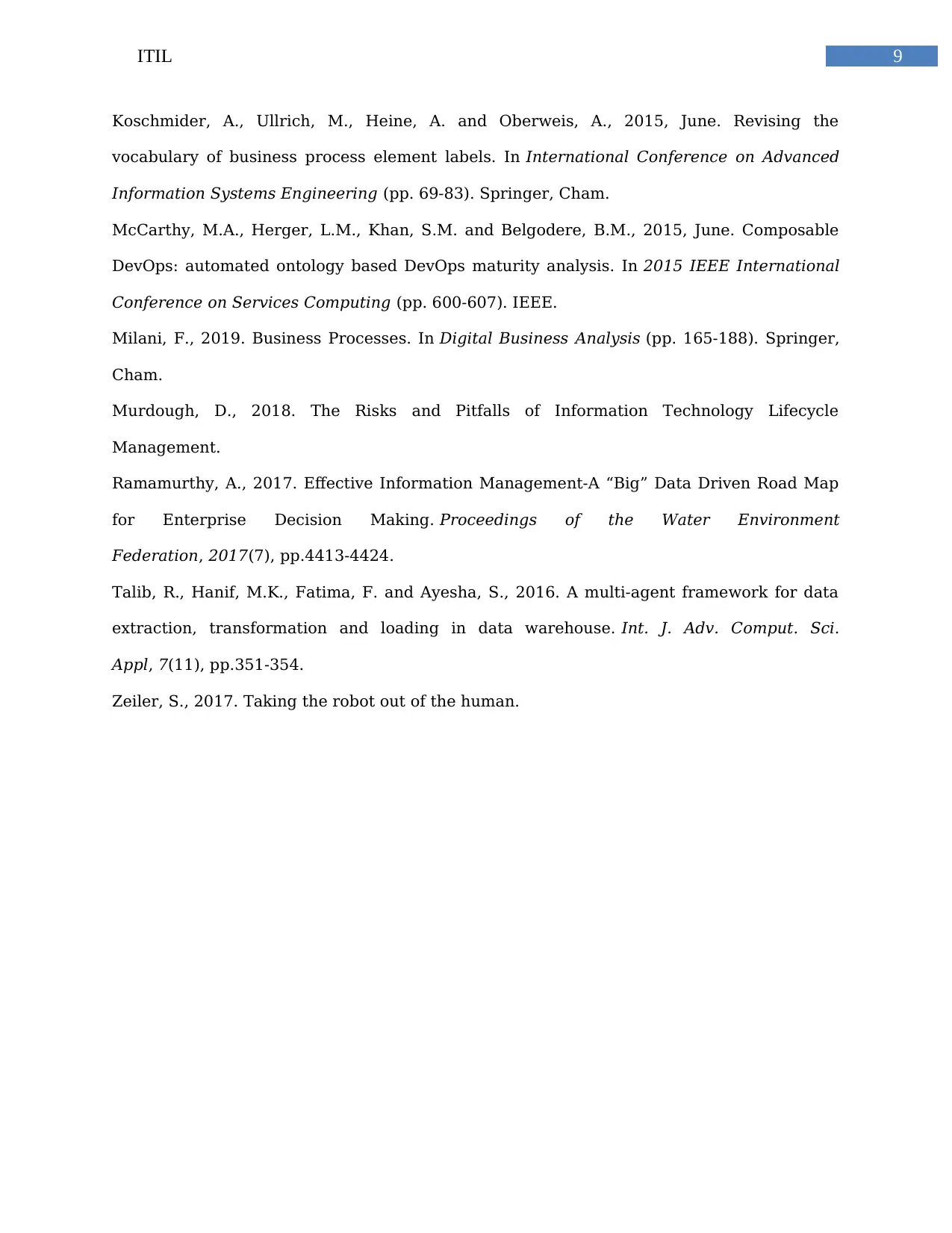
9ITIL
Koschmider, A., Ullrich, M., Heine, A. and Oberweis, A., 2015, June. Revising the
vocabulary of business process element labels. In International Conference on Advanced
Information Systems Engineering (pp. 69-83). Springer, Cham.
McCarthy, M.A., Herger, L.M., Khan, S.M. and Belgodere, B.M., 2015, June. Composable
DevOps: automated ontology based DevOps maturity analysis. In 2015 IEEE International
Conference on Services Computing (pp. 600-607). IEEE.
Milani, F., 2019. Business Processes. In Digital Business Analysis (pp. 165-188). Springer,
Cham.
Murdough, D., 2018. The Risks and Pitfalls of Information Technology Lifecycle
Management.
Ramamurthy, A., 2017. Effective Information Management-A “Big” Data Driven Road Map
for Enterprise Decision Making. Proceedings of the Water Environment
Federation, 2017(7), pp.4413-4424.
Talib, R., Hanif, M.K., Fatima, F. and Ayesha, S., 2016. A multi-agent framework for data
extraction, transformation and loading in data warehouse. Int. J. Adv. Comput. Sci.
Appl, 7(11), pp.351-354.
Zeiler, S., 2017. Taking the robot out of the human.
Koschmider, A., Ullrich, M., Heine, A. and Oberweis, A., 2015, June. Revising the
vocabulary of business process element labels. In International Conference on Advanced
Information Systems Engineering (pp. 69-83). Springer, Cham.
McCarthy, M.A., Herger, L.M., Khan, S.M. and Belgodere, B.M., 2015, June. Composable
DevOps: automated ontology based DevOps maturity analysis. In 2015 IEEE International
Conference on Services Computing (pp. 600-607). IEEE.
Milani, F., 2019. Business Processes. In Digital Business Analysis (pp. 165-188). Springer,
Cham.
Murdough, D., 2018. The Risks and Pitfalls of Information Technology Lifecycle
Management.
Ramamurthy, A., 2017. Effective Information Management-A “Big” Data Driven Road Map
for Enterprise Decision Making. Proceedings of the Water Environment
Federation, 2017(7), pp.4413-4424.
Talib, R., Hanif, M.K., Fatima, F. and Ayesha, S., 2016. A multi-agent framework for data
extraction, transformation and loading in data warehouse. Int. J. Adv. Comput. Sci.
Appl, 7(11), pp.351-354.
Zeiler, S., 2017. Taking the robot out of the human.
1 out of 10
Related Documents
Your All-in-One AI-Powered Toolkit for Academic Success.
+13062052269
info@desklib.com
Available 24*7 on WhatsApp / Email
![[object Object]](/_next/static/media/star-bottom.7253800d.svg)
Unlock your academic potential
Copyright © 2020–2025 A2Z Services. All Rights Reserved. Developed and managed by ZUCOL.





